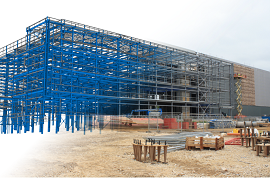Main author
Michael BrooksInterview with Melanie Leech

|

|
The British Property Federation (BPF) is the membership organisation for, and the voice of, the UK real estate industry. It aims to represent and promote to government and regulatory bodies the interests of all those with a stake in real estate in the UK – owners, developers, funders (equity and debt), agents and advisers.
Designing Buildings Wiki sat down with BPF Chief Executive Melanie Leech to discuss some of the wide-ranging issues facing the real estate sector today - from tackling the housing crisis with the 'win-win situation' of Build to Rent, to the impacts of Brexit, and the possibility of a future asset bubble.
| Designing Buildings Wiki (DBW): You moved to the BPF from the Food & Drink Association. What was it about the challenge presented by the real estate sector that drew you to the role? |
Melanie Leech (ML):
Before the Food & Drink Association I was in the civil service for most of my career, so what I’m interested in is public policy and how you shape policy, legislation and decision-making around big challenges.
Both food & drink and real estate are sectors that are absolutely central to the quality of our lives, as well as being important for economic success. Commercial real estate contributes about £95 billion each year, but there’s also the ‘value-add’ of creating infrastructure which enables us to be more productive, as well as creating great places where people work, live and play, and the contribution that can make in terms of social cohesion.
| DBW: What are the BPF’s views on Heathrow expansion and the HS2 developments? |
ML: We are incredibly supportive of investment in infrastructure (although we don’t tend to champion individual projects) and the recent announcements are a very welcome statement of commitment.
Though important, it’s not just the big headline projects; quite often it’s the smaller investments that can unlock particular sites and make a real difference to local communities country-wide.
| DBW: The BPF has been trying to encourage and promote to the Government the idea of Build to Rent as a means of tackling the housing shortage. Could you explain the BPF’s approach to Build to Rent? |
ML: There are a number of key themes that we are trying to promote with Build to Rent. The first is that rental is now the second-largest form of tenure in the UK. To focus on increasing supply to tackle the housing shortage, you have to increase property across all tenures.
Secondly, Build to Rent brings in genuinely new investment to housing. As a concept, it is interesting to long-term investors like pension funds that want a long-term income stream, and like the social contribution of high quality rental.
Finally, you can deliver rental accommodation more quickly than houses to buy, so if you want to tackle the housing shortage - driving early implementation of housing, bringing in new investment and delivering more quickly, seems to us to be a win-win situation for the government.
| DBW: In Sept 2016, RICS reported that 86% of landlords had ‘no plans whatsoever’ to increase their rental portfolio. What do you think the government could be doing to encourage rather than dampen investment in Build to Rent? |
ML: You have to separate out Build to Rent, which is by-and-large about institutions building high quality residences in a managed block of hundreds of units, from traditional landlords who are often involved on a much smaller scale. Because the business model is very different, it’s quite hard to compete; you need things like covenants which make it clear that the land is for rental properties, and that helps to even out the playing field.
I think the 3% stamp duty surcharge is at the top of the list in terms of things that have dampened rather than helped to stimulate investment, so the government should really think about reversing that.
| DBW: In your experience to date, do the government seem receptive to the idea of Build to Rent? |
ML: Yes I think they are. Certainly over the summer and in the Autumn Statement, you’ve seen a focus away from demand-side measures, which were much more about helping people to buy up the supply that’s already there. Instead the government is now focusing increasingly on stimulating the supply-side.
I think we’re getting the message across that rental is an important part of the solution. We’re working very closely with the Housing Minister and the government to work out the best way in which they can stimulate that investment.
| DBW: On the subject of the Autumn Statement, what were your thoughts on the banning of letting agency fees? What might this mean for agents and landlords? |
ML: Most large scale Build to Rent landlords don’t actually charge fees so I don’t think we, on their behalf, will be particularly concerned about that. But it will be interesting to see and work through the details because there will be costs bound up that need to be met somewhere along the line. But in principle, I don’t think we’re too concerned about it.
| DBW: What is the BPF’s attitude towards BIM and its adoption by the private sector? |
ML: We are supportive but it is early days. The government is trying to, and will, play a huge role in trying to drive adoption of BIM through its procurement policies. There are issues and concerns, things to be worked through around contracts, liability, cost, protecting intellectual property, and so on.
I don’t think we have an informed view yet about what the implications are. The early adopters have driven good practice and it works for them, but I think we’re some way from being able to say there is confidence and that those issues have been resolved in a way that will drive through general adoption at this stage. That’s not to say though that it isn’t an objective to aim for.
| DBW: What advice would you give to the government regarding the Brexit negotiations? |
ML: Our concerns are pretty similar to those of our customer base: about access to skills and talent, making sure that we can ensure maintain construction activities, about our customers and their ability to move talent around in a way that they want to do, that means the UK will continue to be a competitive place for global companies.
It’s important to make sure that while we negotiate our exit from the EU we don’t put everything else on hold, there’s lots of stuff we can be doing. So we would say, on the one hand, protect our ability to employ talent, protect the UK’s (and London’s specifically) place in the global marketplace, and keep the foot on the pedal of all the good things that are going on at the moment.
Because these are all critical to our economic success post-Brexit; things like investment in infrastructure, maintaining a stable and competitive tax system, all of these things are more important than ever.
| DBW: Do you have much of a sense from members and the different groups that BPF represents about the scale of the impact on real estate of leaving the EU? |
ML: It’s really very early to say for a number of reasons. For a start, it looks different across a number of sectors. There is a lot more uncertainty in the commercial office market than some others just because of all the issues that are up in the air.
If you look at the logistics sector, even accommodation, healthcare, housing; there is a lot less potential impact because we will still need to house people, still have an ageing population that will need to be cared for, etc. So it’s quite hard to know at this stage whether the impacts that we’re seeing in certain parts of the market are more than just current uncertainty.
| DBW: What are your thoughts on Labour’s proposals to encourage councils to build by lifting the local authority borrowing cap? |
ML: Really interesting actually. The idea of finding more innovative ways of public-private partnership will be key to a lot of the regeneration and investment that will need to go into towns and cities across the country. Anything that can be done, any new thinking around trying to make that easier for the public, as well as the private, sector is important and encouraging.
| DBW: Are you concerned about the rate of foreign investment into real estate, particularly in London, and what this may do in terms of creating an asset bubble in the near future? |
ML: It’s nowhere near the top of my list of concerns as I think investment into the UK is a good thing. It’s not surprising, with what’s happened with the currency in the last few months that London and the UK is an attractive place for overseas investors, but I think that generates all kinds of benefits across the economy.
Where it does become a concern for real estate is more to do with the reputational myths that go around; reports about empty residential properties in central London which really is primarily a Zone 1 problem but tends to distort perceptions of what’s happening in the marketplace, and of the value that foreign investment brings to the UK.
| DBW: What projects are BPF focusing on going forwards in 2017? |
ML: Making sure we have a strong input into the government’s Brexit negotiations will be top of our list, but that unlocks a lot of things we would probably be focusing on anyway – skills in the industry, how we make an important contribution to productivity, availability of land, a stable tax system, making the planning system work better.
We’ve spent a lot of time in recent years building our profile in the regions, which will be important for us going forward as the devolution agenda continues to unfold.
More parochially, we have an internal change programme going on so that as an organisation we are properly representing our members’ views, trying to create more ways in which members can get involved with us, and drive an inclusive agenda. It isn’t a particularly diverse sector so we’re trying to do anything we can to help make it more attractive to younger people, minority groups, and so on. There’s a whole host of things going on!
For more information on the BPF see here.
[edit] Related articles on Designing Buildings Wiki
- Affordable housing.
- British Property Federation.
- Build to rent.
- Interview with Carol Lynch, CYT.
- Interview with David Orr, NHF.
- Interview with FMB.
- Interview with Julie Hirigoyen, UK-GBC.
- Interview with Kevin Borg, founder of KJB Building Consultants.
- Interview with Labour's Shadow Housing Minister.
- Interview with Mark Farmer.
- Owen Hatherley interview.
- Stamp duty.
- Real Estate Investment Trusts.
- What does Brexit mean for construction?
Featured articles and news
RTPI leader to become new CIOB Chief Executive Officer
Dr Victoria Hills MRTPI, FICE to take over after Caroline Gumble’s departure.
Social and affordable housing, a long term plan for delivery
The “Delivering a Decade of Renewal for Social and Affordable Housing” strategy sets out future path.
A change to adoptive architecture
Effects of global weather warming on architectural detailing, material choice and human interaction.
The proposed publicly owned and backed subsidiary of Homes England, to facilitate new homes.
How big is the problem and what can we do to mitigate the effects?
Overheating guidance and tools for building designers
A number of cool guides to help with the heat.
The UK's Modern Industrial Strategy: A 10 year plan
Previous consultation criticism, current key elements and general support with some persisting reservations.
Building Safety Regulator reforms
New roles, new staff and a new fast track service pave the way for a single construction regulator.
Architectural Technologist CPDs and Communications
CIAT CPD… and how you can do it!
Cooling centres and cool spaces
Managing extreme heat in cities by directing the public to places for heat stress relief and water sources.
Winter gardens: A brief history and warm variations
Extending the season with glass in different forms and terms.
Restoring Great Yarmouth's Winter Gardens
Transforming one of the least sustainable constructions imaginable.
Construction Skills Mission Board launch sector drive
Newly formed government and industry collaboration set strategy for recruiting an additional 100,000 construction workers a year.
New Architects Code comes into effect in September 2025
ARB Architects Code of Conduct and Practice available with ongoing consultation regarding guidance.
Welsh Skills Body (Medr) launches ambitious plan
The new skills body brings together funding and regulation of tertiary education and research for the devolved nation.
Paul Gandy FCIOB announced as next CIOB President
Former Tilbury Douglas CEO takes helm.
UK Infrastructure: A 10 Year Strategy. In brief with reactions
With the National Infrastructure and Service Transformation Authority (NISTA).





























